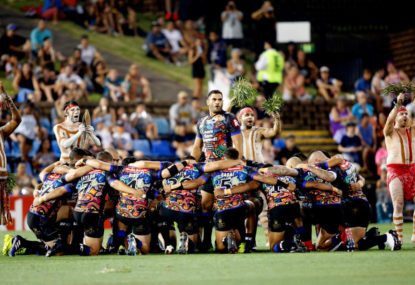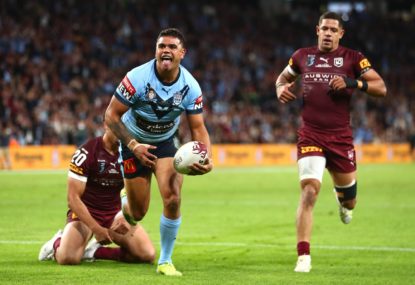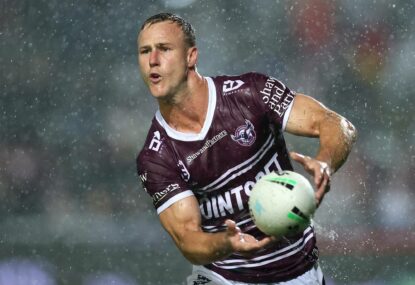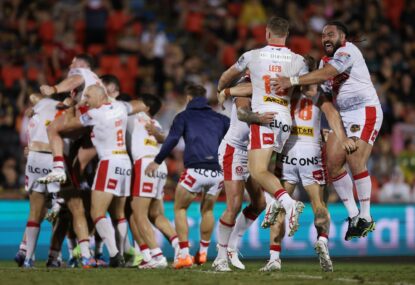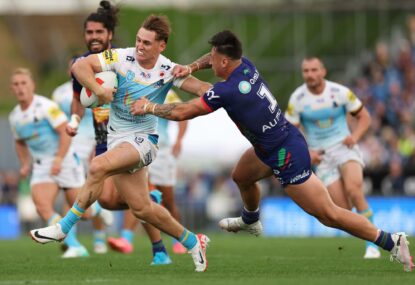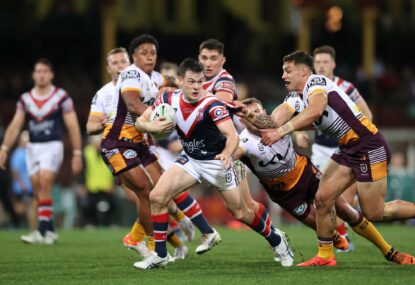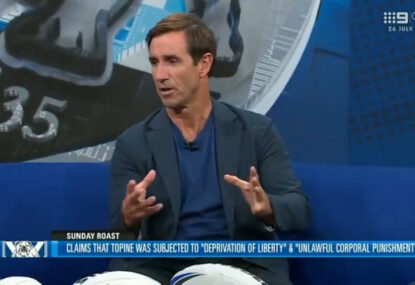Last Friday night the Indigenous All Stars put in arguably their best performance since the inception of the All Stars format in 2010.
Scoring the highest number of points to be awarded to any side in an All Stars game and equalling their 26-point win margin of 2013, it was a scintillating introduction to the full-length footy year.
Earlier in the week, Johnathan Thurston suggested that the Indigenous side should be given more opportunities throughout the year.
Watching the boys as they took the field on Friday night, it was hard to disagree.
From the very outset, their communication was utterly seamless.
Club allegiance never seems more fickle than at the beginning of the NRL season. Pretty much every club has to get used to a slew of new faces and say goodbye to a slew of old faces.
It was even more dramatically clear, then, that the Indigenous side were playing for something more than a club.
Even the Kangaroos don’t always match that level of synergy and common purpose.
The connection was all the more incredible in that the Indigenous side had only had two training sessions in the immediate buildup to the match – a preliminary one-hour practice and a Captain’s Run of about forty minutes.
Their elegant efficiency was therefore a tribute to the heritage and cultural events that have been implemented to bond the team, as well as the wider visibility around the indigenous community in the buildup to the match.
Stan Grant’s speech, in particular, seems to have resonated, with Greg Inglis citing it as key to his motivation in the build up to the match.
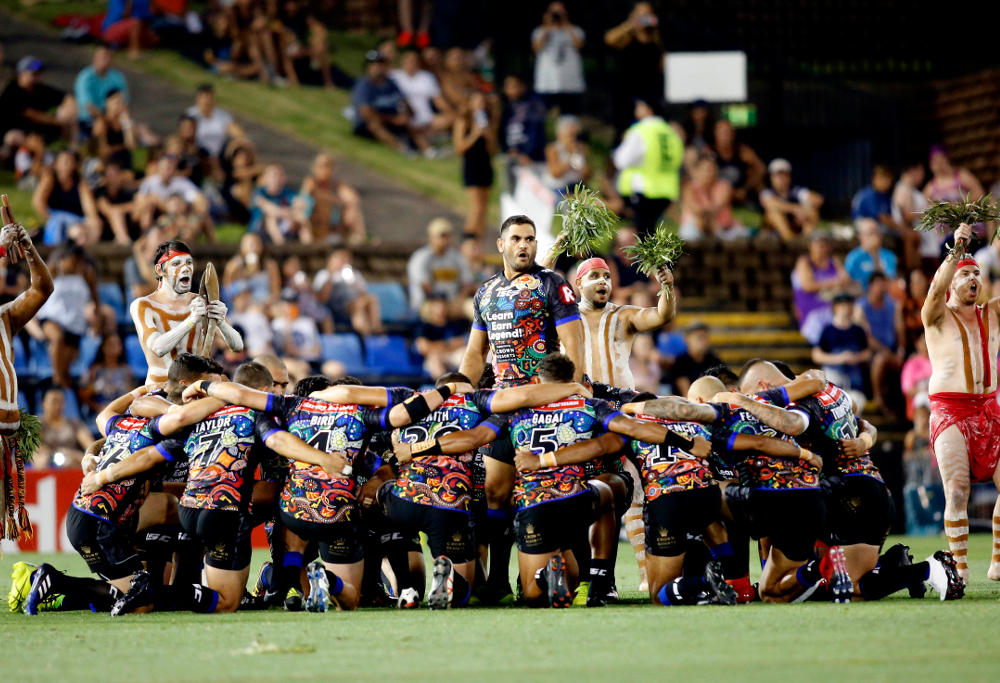
Playing on the brink of a record-breaking heatwave just seemed to create an even more urgent sense of solidarity and communion.
Over the first half, we were given a lesson in pure footy professionalism, with barely an error in judgment from the Indigenous side.
Inglis, in particular, always brings something extra to All Stars clashes.
In his pride, presence and stature on the field, you can glimpse how it would feel for the Indigenous community if they were always afforded this kind of visibility and inclusion.
It’s not hard to see why he’s such a pillar of strength, both at the Rabbitohs and beyond.
With him and Thurston as co-captains, the Indigenous side must have had an invincible sense of belief.
Add to that the fact that Andrew Fifita clearly had something to prove to Mal Meninga in the wake of his Four Nations snubbing – and the stage was set for a powerhouse performance from the Indigenous side.
Before the game even started, however, it felt as if the Indigenous players had won with their war dance.
More complex and choreographed than recent years, this was an utterly spine-tingling spectacle.
I found myself wondering why the haka has managed to become so integral to rugby union and yet this kind of Indigenous ceremony has never made its way into rugby league.
With each player gathering in a circle and then adopting their own particular postures and expressions as they faced the World team, it felt as if they were channelling their positions and proclivities on the field into a cross-section of Indigenous pride.
I can’t think of a better ceremony to express both the unity and the diversity of Indigenous peoples.
Following straight on from that momentum, Joel Thompson and Jack Bird set up a try in the opening minutes, which was just as rapidly converted by Thurston.
For Bird, it must have been a satisfying experience to get one down for the Indigenous boys as soon as he got ball in hand for his first All Stars appearance.
Minutes later, Blake Ferguson found open space in the middle of the opposition’s sliding defence, taking advantage of the poor communication between the World backline and halves to plant the Steeden over the line.
Granted, it was more a matter of World sloppiness than Fergo’s ingenuity, but it still felt continuous with his stint for the Kangaroos at the end of last year, among the very best in the Four Nations.
It was with the third try, however, that things really started to get sublime.
Recovering the ball from a fumbled tackle, Thurston passed it to Taylor who passed it back again only to receive it from J.T. for a second time and bring the score to 14-0 after only twelve minutes.
Those kinds of back-and-forward exchange would prove to be characteristic of the Indigenous side, who often felt as if they were having a conversation with the Steeden, leaving the World side to stumble in their wake.
Admittedly, World started to recover again towards the end of the second half, with David Mead and Nene Macdonald bringing in the only World tries of the night, even as Jarrod Croker failed to convert either.
That said, there was still a lack of conviction.
Mead’s try, in particular, felt conjectural, with the referee calling it and the Bunker only allowing it because they didn’t have sufficient evidence to overturn it.
Macdonald’s four-pointer was more impressive – a perfectly timed putdown ten seconds out from the bell.
Still, the World backline were struggling to keep up with the Indigenous side.
A bomb from Thurston at the fifteen minute mark was fumbled by Mead and only saved by Mitchell Moses at the last minute from what would otherwise have been a certain Indigenous try.
As Gus Gould put it, there was “no semblance of cohesion” to the World side.
To some extent, that was a result of more unfamiliar combinations for World.
After all, the Indigenous boys had more of a Maroons pedigree and synergy to draw upon, especially among Thurston, Inglis and Dane Gagai, who put in some Origin-worthy moments.
Yet the Indigenous platers should also be commended for how well they unsettled the World players, in the way that an ultra-organised outfit can often breed disorganisation among their opponents.
Accordingly, they responded emphatically to Macdonald’s four pointer less than a minute into the second half, with their deftest moment of the night.
Choosing to run the ball on the final tackle, Thurston passed the Steeden across the left side of the field where it finally found Bevan French, who in yet another counter-intuitive moment of genius chose to relinquish his trademark speed to banana kick it back to Thurston, who was still coming up the middle.
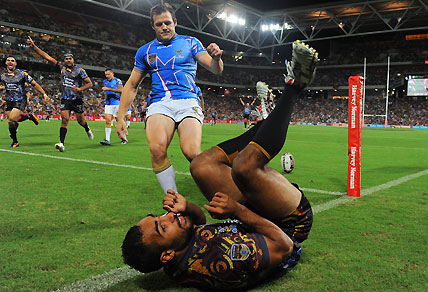
Bookended by Thurston, who converted just as effortlessly moments later, it was a pure example of why people love rugby league.
For me, it already stands of one of Thurston’s best moments this year.
Yet the GOAT arguably put in an even greater move at the one hour mark, receiving the Steeden from Inglis at dummy-half and chipping it across the field to Gagai, who managed to catch it on the full and comfortably ground it behind the goal-lines, setting J.T. up for another effortless conversion.
So brilliant was Thurston’s ability to pinpoint just where Gagai would be that his split-second judgement seemed to defy any single sporting skill set, sending the commentators in search of analogies from other codes and games, from soccer to Tom Brady.
Even Gagai himself seemed more dumbfounded than excited at realising he’d put down a four-pointer, telling the interviewer that he had pretty much stayed onside and allowed Thurston to work his magic.
Still, it was a testament to Gagai’s ability to seize the moment as well, a worthy sequel to his Origin-esque dash down the field in the first half.
Still, it wasn’t all about the four-pointers.
Inglis busting through the line at the 48th minute off the back of a Fifita flick pass was every bit as good as a try, as he managed to dispose of Mead (twice) and Tepai Moeroa along the way.
Drawing on Fifita’s energy, who had managed to scramble the Steeden out from under a pile of World defenders, and seguing into Thurston’s brilliance, who took over from G.I. downfield, it was a perfect testament to the synergy of the Indigenous team.
The final try of the night was from Leilani Latu.
It may not have been as sublime as the previous Indigenous efforts, but it didn’t have to be.
Following on from Latu’s try last year, it cemented the heritage and longevity of the Indigenous outfit.
After such a perfect game of footy, the question on everyone’s lips seemed to be – when next?
With the All Stars match expanding beyond Queensland for the first time, it felt like a watershed in elevating the Indigenous team to a new visibility.
During the match, Gould suggested that the Indigenous boys might find a berth at the rugby league World Cup.
In the last couple of days, Thurston has suggested that the team might be better suited to playing Papua New Guinea, New Zealand or one of the Pacific Island Nations.
Personally, I think Thurston is on the money.
Setting up a regular series with other Pacific nations would be a great way to expand the format and to celebrate the other Indigenous voices that go into the rugby league community.
Whatever the format, the time has come for an expansion of what the Indigenous side can do.
When the final siren sounded on Friday night, I found myself wondering if I had already watched the most passionate and professional eighty minutes of footy this year.
That kind of experience and spectacle needs to be repeated. Now that the Indigenous-World format has been around for half a decade, it’s time.
In the minutes before kickoff, Stan Grant told the Indigenous side that “we are a successful people and we need to reclaim that success.”
In their pride and determination, the Indigenous players translated Grant’s voice directly into footy. Let’s hope that voice now finds an even wider audience.





























































































